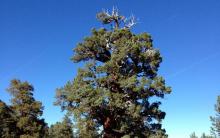GARDEN GIGANTOMANIA: PLANTS WITH LARGE LEAVES
Large “architectural” plants with beautiful leaves have recently become increasingly common in our gardens.
What can unite them, quite different, into one group? Of course, huge leaves and a heroic appearance. Each of the flowers with large leaves claims to be a soloist; most of them are able to decorate the shady corners of the garden.
Today again - ten, this time it contains photographs and descriptions of plants, not necessarily tall, but always having large or giant leaves.
Buzulnik serrata is a monumental plant up to a meter tall with large leaves and spectacular inflorescences-baskets, collected in a paniculate inflorescence. A couple of varieties are widely known: Desdemona - with green leaves with a lilac lining, and Othello - with purple-green leaves. The contrasting combination of orange flowers with large rounded purple leaves makes buzulnik a leader in the shady garden.

Buzulnik serrated Othello
The beauty of peltifillium thyroid is in the huge shield-shaped leaves that rise above the ground on strong thick petioles up to 90 cm in height. This plant, also called darmera, looks good not only in single tapeworm plantings under trees, but also in company with any shade-loving perennials - hostas, Rogersias, astilbes, meadowsweet.

Darmera and hosts. Photo by Alevtina Kovina
Rogersia (podophyllous and horse chestnut-leaved) - impressive plants that decorate any shady composition with the expressive texture of leaves with relief veining and huge inflorescences.

Rogersia podophylla and hostas. Photo by Alevtina Kovina
Giant hosts different varieties differ not only in shape, but also in the color of large leaves. These giants can form bushes up to 0.9 m high and up to one and a half meters in diameter. The most popular varieties of giant hostas are Elegans, Empress Wu, Fragrant Bouquet, Blue Angel, Abiqua Drinking Gourd.
Bergenias grow in any place - light, semi-shaded and shady. Their large clumps are decorative from spring to autumn, beautiful near shrubs, coniferous and deciduous, in mixed borders, near ponds, on rocky areas.

Bergenia thickleaf
Another giant in the garden is the American laccone (Phytolacca). Its thick, woody stem dies off every year, and each summer the lacconios manages to gain mass weighing up to 10 kg. In autumn, shiny inedible dark berries are formed on the flower stalks, which, falling off, give rise to multiple self-seeding.

American Lakonos (Phytolacca)
Macleay cordate is also not a plant for a small garden; it is powerful, tall and reproduces quickly through underground shoots. The large leaves of maclea are heart-shaped-lobed, bluish-green above and whitish below, and remain decorative until autumn. Macleaia blooms in summer with small flowers collected in large plume inflorescences.

Macleay cordate
Butterbur is a very unique ornamental plant. It requires large areas, as it easily grows, displacing other plants. Butterbur is ideal for decorating fences, walls of buildings and outbuildings.
Astilboides is good in solitary planting, but is very effective on the shore of a pond if there are plants with bright flowers next to it. When planting astilboides in fertile soil, it will grow without replanting for many years.

Astilboides lamellar
And the last, tenth plant with large leaves is castor bean. Although it is an annual, it would be unfair to ignore it, because in just 3 months a bush up to 2 meters high grows from a seed. Particularly impressive are varieties with red leaves.

Castor bean











The most beautiful motorcycles in the world
Which sea is the cleanest in the world?
Top 10 Most Expensive Furs
The largest and most luxurious casinos in the world
Knightly orders of Europe XI - XIII centuries